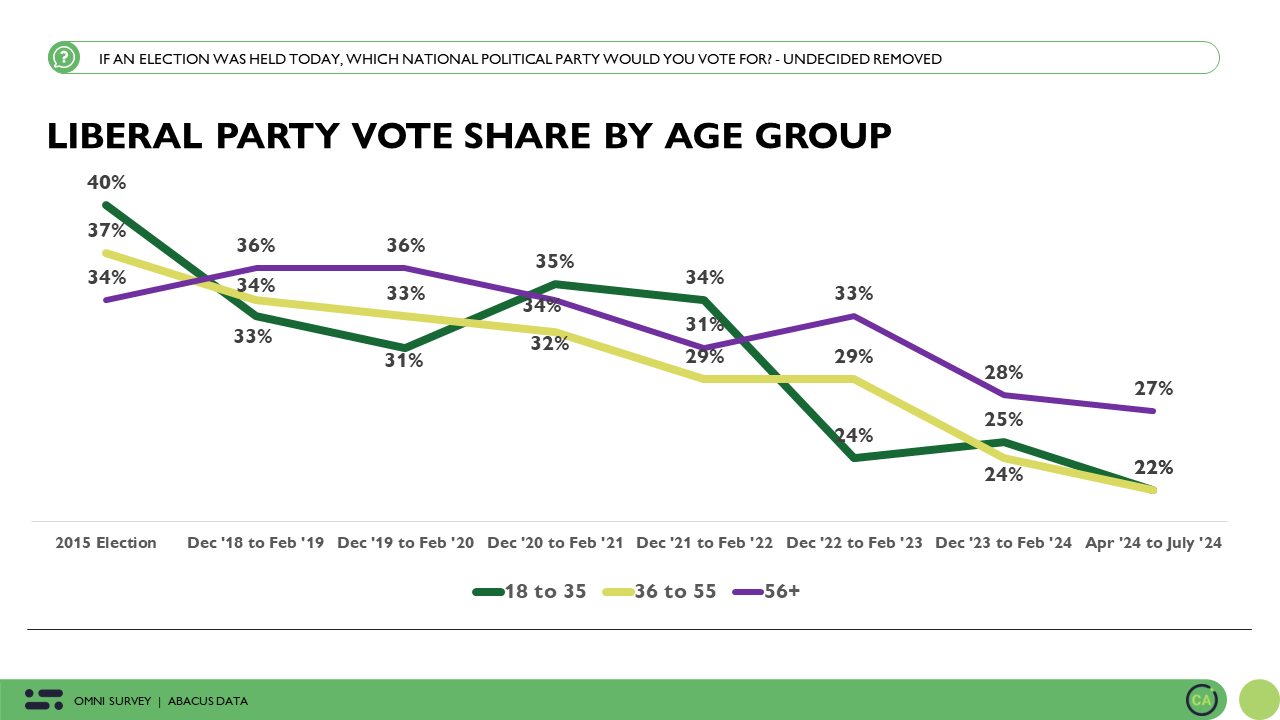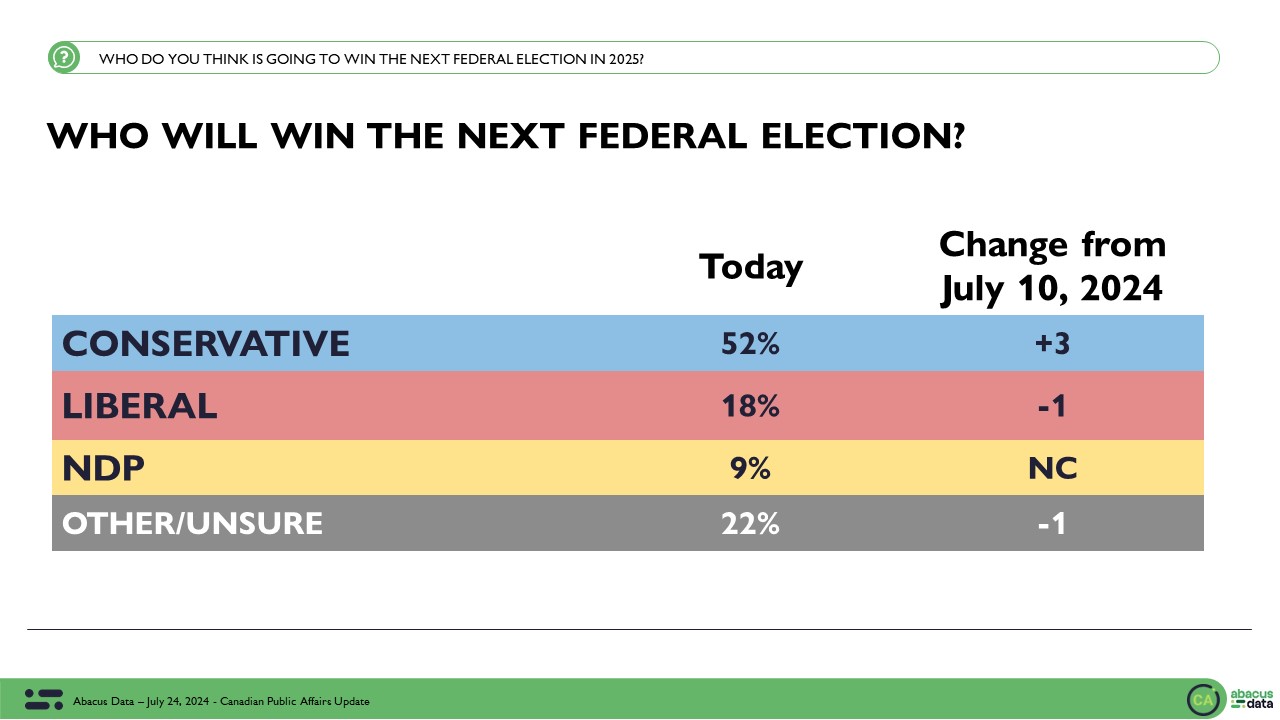GRIT SUPPORT BROADENING WITH TIME
August 29, 2016

Our latest survey interviewed more than 2,000 respondents and covered a host of political topics.
Our first release from this package of data covers the regular political bases.
ACCESSIBLE VOTER POOLS
At the beginning of 2015, all three major parties had accessible voter pools of a similar size. Today, the Liberals have a 20-point advantage over the NDP and a 22-point advantage over the Conservatives. To some degree, one might argue that this has something to do with the fact that the Conservatives and the NDP don’t have permanent leaders, except this gap really had emerged by the end of the last election campaign.
Today, 67% say they would consider voting Liberal, compared to just 47% for the NDP and 45% for the Conservatives. The gap in accessible voter pool is arguably the Liberals strongest asset and the critical factor that new leaders of the NDP and Conservatives will need to change if their goal is to form a government.
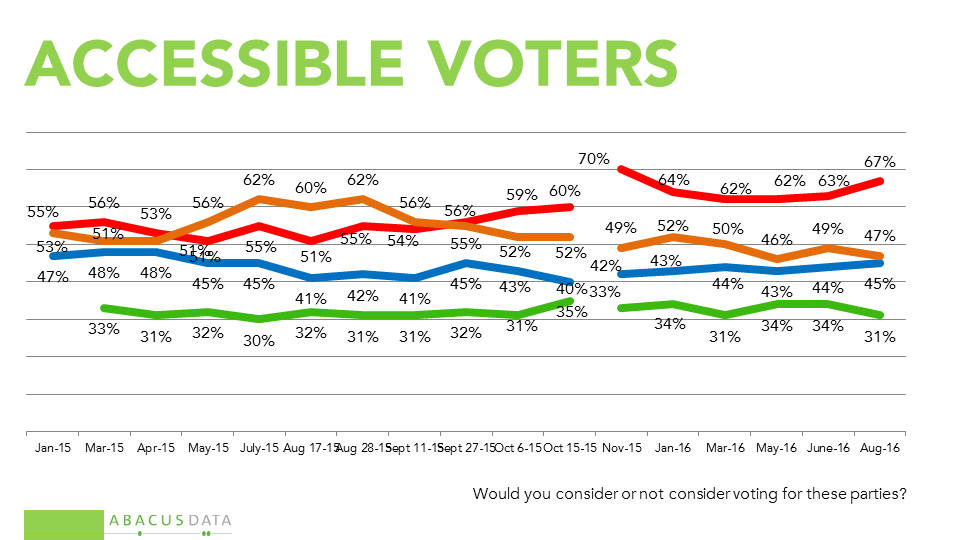
CURRENT VOTING INTENTION
A year ago, all three major parties were polling within three points of each other. Today the gap from first to third is 30 points.
If there were an election tomorrow, the Liberals would win 46% support, 6-points better than their result last fall. The Conservatives are steady at 28% while the NDP is at 16%. Both the NDP and Conservative are four points below their election result last year.Regional breakdowns show the Liberals with a 23-point lead (over the NDP) in Quebec, a 23-point lead in BC, and a 17-point lead in Ontario.

Regional breakdowns show the Liberals with a 23-point lead (over the NDP) in Quebec, a 23-point lead in BC, and a 17-point lead in Ontario.
When it comes to gender, the Liberals lead by 15 points among men, and by 22 points among women. They lead among all age groups with a 30-point lead among those under 30 and a 12-point lead among those 60+.

Breaking down these results a bit more reveals the Conservatives greater challenge is among women under 45, where the party is 29-points behind the Liberals.
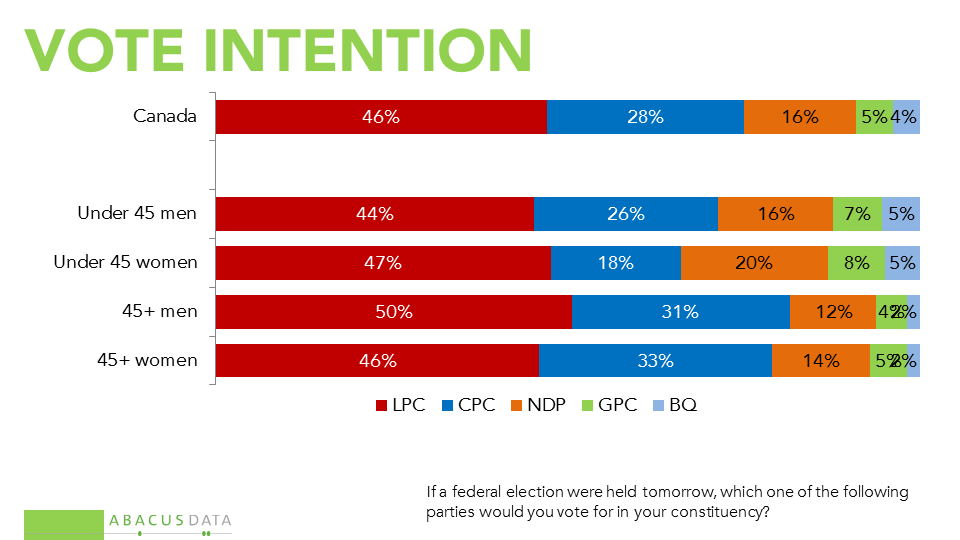
Another critical pattern is the difference between urban and rural voters, especially west of Ontario. West of Ontario, the Conservatives have a narrow lead among rural voters, while the Liberals have become highly competitive in urban and suburban areas. East of Manitoba, the Conservatives are far behind the Liberals in urban and suburban areas and are 14 points back in rural areas.

The relative competitiveness of the Conservative Party in rural Canada is mostly a function of how men feel about their choices. Among rural men, the two parties are only 4 points apart. Among rural women, the Liberals have a 17-point lead.

APPROVAL OF THE GOVERNMENT
Our latest survey finds 57% approve of the job the federal government led by Justin Trudeau is doing, the highest number we have recorded since he took office, and 25-points above where Mr. Harper stood entering the last election.

Approval levels are above 50% across the country with the exception of Alberta, where 39% approve and 47% disapprove. The Liberals obtained 25% of the vote in Alberta last fall.
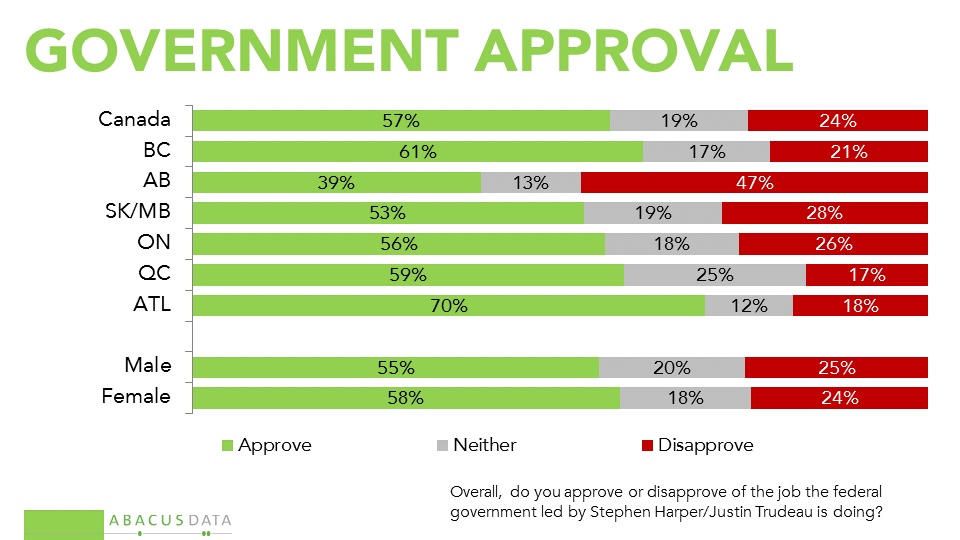
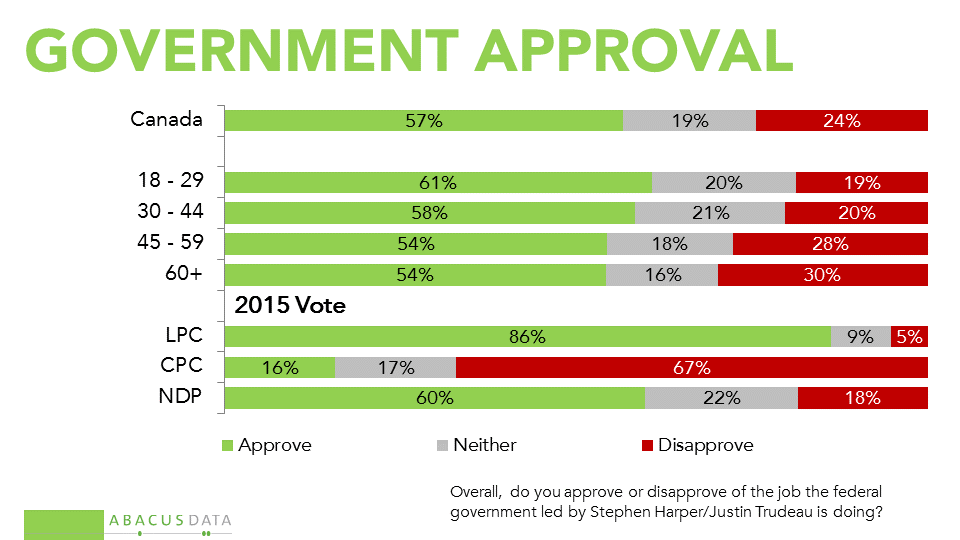
Approval of the government is above 50% among all religious groups, except Evangelical Christians, among whom 39% approve, and 46% disapprove of the Trudeau government.

Approval levels are higher among those whose household income is below $200,000, but even among those above that threshold, approval is 49%, disapproval 33%.
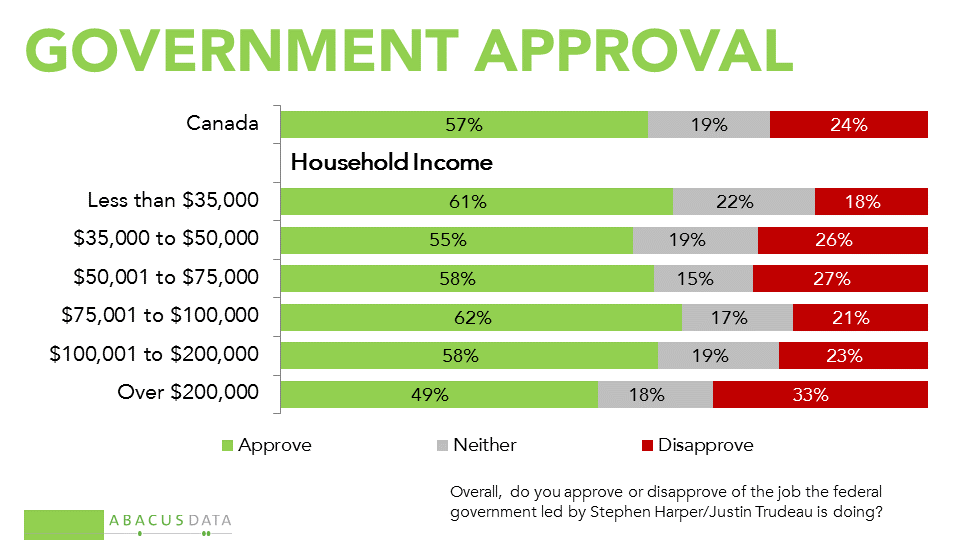

Perhaps the most interesting stories under the surface of broad approval is the fact that the Trudeau government is winning the approval of the broad majority of those on the left (above 70%), the majority (53%) of those on the centre, and even the plurality of those on the centre right (48%-34%). It is only the relatively small portion of the population who self-describes themselves as “right” (7%) where the majority disapproves.
Finally, while the economic mood is improving (more on that in a later release this week), only about half of the population feels the economy is in good shape today, the other half would say poor or very poor. Among the 42% who say the economy is “poor,” more people approve (44%) than disapprove of the performance of the government.\
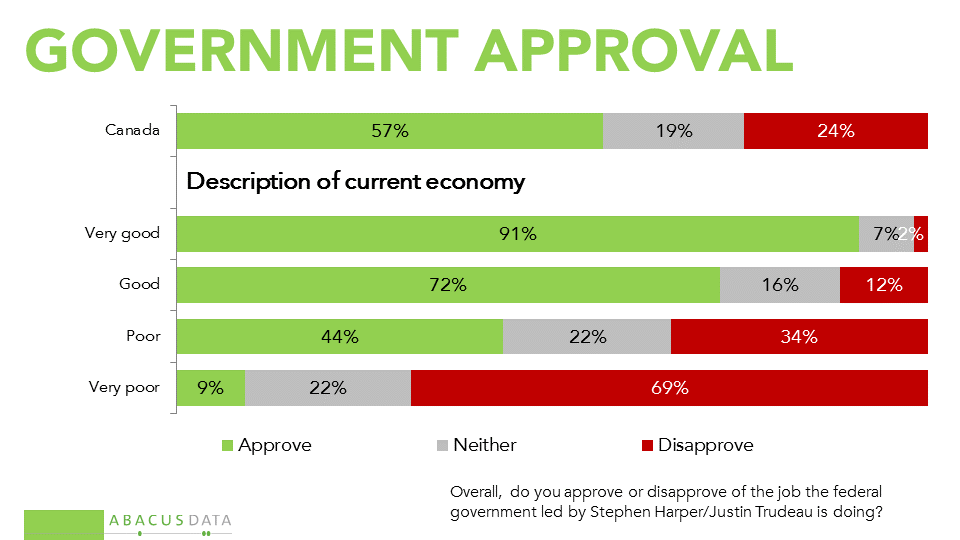
THE UPSHOT

Bruce Anderson: “For many months now, some have wondered if the popularity of the new government would survive the inevitable tough policy tests it would face. As the new government closes in on a year in office, with the inevitable challenges that have occurred, some critical choices have been made, and public support remains pretty robust.
Perhaps more interesting is that the extensive regional and partisan polarization that has marked Canadian politics for several years may be dissipating. Voters on the centre right seem pleased with the choices the government is making as do those on the left. Many voters in the West, who didn’t vote for this government, seem to be accepting the choices Mr. Trudeau is making.
For the other two major parties, this establishes that they cannot take for granted that their approach to the next election can be about rallying a base against the incumbents: they will need to increase the appeal of their parties among those who would not currently consider them.
About 1 in 5 NDP voters has drifted towards the Liberals, and the number of Conservative voters who are angry at the Liberals is far less than would be needed to win an election.”

David Coletto: “The broad public support for the Liberal government we saw soon after the election has persisted and strengthened. Approval is up 5-points since March and the Liberals would win a larger share of the vote today than they did in last year’s election.
Part of this extended run of goodwill might be explained by the fact that Mr. Trudeau lacks any alternatives for Canadians to compare as potential replacements. More likely, the popularity of Mr. Trudeau and his government is a result of its approach to governing and the emotional connection it has made with millions of Canadians, including many who didn’t vote Liberal. Despite some challenges and mistakes, the Liberals have governed like Canadians expected they would. They promised a progressive, positive, and ambitious government. Most progressive Canadians, and even some of those on the right, are happy with what they have seen so far.”
METHODOLOGY
Our survey was conducted online with 2,010 Canadians aged 18 and over from August 22 to 25, 2016. A random sample of panelists was invited to complete the survey from a large representative panel of over 500,000 Canadians.
The Marketing Research and Intelligence Association policy limits statements about margins of sampling error for most online surveys. The margin of error for a comparable probability-based random sample of 2,010 is +/- 2.2%, 19 times out of 20.
The data were weighted according to census data to ensure that the sample matched Canada’s population according to age, gender, educational attainment, and region. Totals may not add up to 100 due to rounding.
Abacus Data Inc.
We offer global research capacity with a strong focus on customer service, attention to detail and value-added insight. Our team combines the experience of our Chairman Bruce Anderson, one of Canada’s leading research executives for two decades, with the energy, creativity and research expertise of CEO David Coletto, Ph.D.



